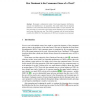Free Online Productivity Tools
i2Speak
i2Symbol
i2OCR
iTex2Img
iWeb2Print
iWeb2Shot
i2Type
iPdf2Split
iPdf2Merge
i2Bopomofo
i2Arabic
i2Style
i2Image
i2PDF
iLatex2Rtf
Sci2ools
TSD
2004
Springer
2004
Springer
How Dominant Is the Commonest Sense of a Word?
We present a mathematical model of word sense frequency distributions, and use word distributions to set parameters. The model implies that the expected dominance of the commonest sense rises with the number of corpus instances, and that, particularly for commoner words, highly uneven distributions are to be expected much more often than even ones. The model is compared with the limited evidence available from SEMCOR. The implications for WSD and its evaluation are discussed.
Commonest Sense Rises | Sense Frequency Distributions | Signal Processing | TSD 2004 | Word Distributions |
| Added | 02 Jul 2010 |
| Updated | 02 Jul 2010 |
| Type | Conference |
| Year | 2004 |
| Where | TSD |
| Authors | Adam Kilgarriff |
Comments (0)

